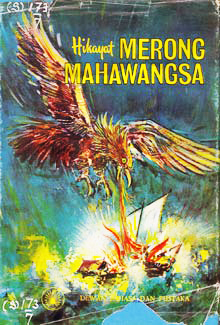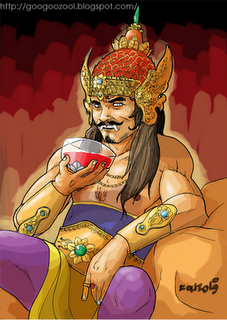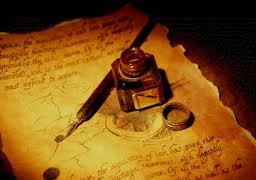I wonder if the people who bought out the Merong book to find out more after the movie came out, found it very disappointing. If you have watched the movie and want to read the book because you are intrigued by the characters…
Don’t bother.
Not because the book is not worth reading but because if you found the movie appealing, you probably like the grand heroic story arc. And the book – just like other ancient Malay texts – doesn’t provide that. Nor was there any development of characters and their feelings, relative to the movie. For example, there was a nice understated love story between Merong Mahawangsa and Embok in the movie. In the book? On p. 12, Merong Mahawangsa established the throne of Langkasuka, by pg. 29, he had a child running around in court. There was no mention of the wife; let alone a scarred one with a sad history.
It was rather odd – because usually a book-movie relationship is the other way round. The movie provides a means of visualization while the text serves as a way to put heart in a narrative, often expositing on the thoughts and feelings that visuals cannot capture. In this case, Merong-in-the-book is a opening chapter of a text chronicling the reigns of the kings of Kedah so, more of a record than heartware.
In any case, don’t read this book unless you can read Malay sentences like this without getting drowsy:
Syahadan maka titah Raja Merong Mahapudisat, kepada menteri keempat – hendaklah saudaraku ambil Gajah Gemala Johari ini, alatkan dengan takhta kerajaan dengan kedab serta langit tirainya dan taburnya dengan dihiaskan sintuk limau pada badannya….
Synopsis of book: The book chronicles several generations of Kedah’s kings, descended from the House of Merong Mahawangsa and culminated in the rise of a Muslim king. Along the way, there’s magic. And cannibals. And an interesting version of the origins of the Bunga Emas tribute from the northern Malay states to Thailand.
At first, I thought it would be a chronological historical record of ancient kings in Kedah. But then, there are three reasons why it doesn’t quite fit the mould of a historical record.
(i) Fantasy elements in the narrative. Giants? A talking gryphon? Using a magic elephant to choose a king? Where would they fit in history?
(ii) Mixed up timelines. For example, Merong Mahawangsa found his kingdom in the time of King Solomon, according to the text. That puts it around 10 BCE. About 6 generations later, Merong’s descendent was said to be living in the time of Prophet Muhammad (7 AD). 6 generations over 1700 years?
(iii) No statement of achievements and not much description of the kingdoms. I kind of expect a king recording the genealogy of his illustrious house to trumpet how their kingdom prospered during their rule. Instead, there are a lot of bald statements about the personality of each king – this one was a good man, that one was very unjust – which wouldn’t be the focus of historical interest. Some of the stories are tales of outright misrule too, justified by the divine lineage.
And – as my sister pointed out – if its a historical record set down by the courts of the king, why didn’t they expunge embarassingly horrible kings such as Raja Bersiung out of the record? If I had a ghastly cannibal as my ancestor, I wouldn’t want to advertise that fact.
So, I find it difficult to decipher the purpose of the text. Who wrote it? Why did they write it? What purpose was it intended to serve?
Even as a literary document, the text doesn’t quite fit. Why did they write so baldly and repetitively? The text spent quite a lot of time expositing on each and every king, some of whom did nothing much but to ascend to the throne and hold meet the people sessions in his court. There are a lot of literary stylistic similarities with other Hikayats eg. Hang Tuah and Salalut as-Salatin – who was the intended audience? And what was the significance of this form?
I was a bit disconcerted to find that the Malaysian professor who wrote the introduction had already listed down these criticisms of the text made by “western scholars” with an orientalist bent. They dismiss such local texts as inaccurate gossips from the courts with no historical value whatsoever, she charged. Oh no, what does that make me? A native orientalist? A brain-washed Anglophilic? I definitely feel disconnected from the text – and I suspect, most Malays would feel the same way too, which is why copies of it was mouldering in Dewan Bahasa and Pustaka until KRU studios came along.
But I also don’t think its enough to defend the historical value of such material and to point out the colonialist bias that previous scholarship was grounded. In order for such criticism to be constructive, one must suggest a way to use these texts as a means of historical analysis and to write a convincing history with these sources. Of course, this intro was written some time agao. Maybe the Malaysian professor who wrote the introduction would have been happy to read Leonard Andaya’s ‘Leaves of the Same Tree: Trade and Ethnicity in the Straits of Malacca‘ (2008) which makes extensive use of Hikayat Aceh, Hikayat Hang Tuah, Hikayat Siak etc. (note: not Merong, though). I do wonder, though, why such a history took so long to emerge and when it did, it didn’t come from within the region. Or perhaps such a history has been written in a non-English language but no one knew about it?
Either way, for the ordinary Malay like me, there is a reverence for these ancient texts without fully knowing why. When I searched for these old text, the Malay salesman in Dewan Bahasa and Pustaka bookstore helpfully guided me away from the soft-cover shelves to a special section. All these ancient hikayats, he proudly stated, are bound in real leather with expensive tooling and gilt-edge pages (and cost a whopping 280 RM). And the text, he said, is perfectly preserved as it was written. At Dewan Bahasa, there are no cheaper versions sitting around in soft covers, waiting to be thumbed through. There are no versions written in modern Malay.
And there we have it, the reverence and the inaccessibility.
Postscript: On second thoughts, maybe I shouldn’t feel too bad about the disconnect. After all, how many native English people like reading Beowulf in Olde English? And by the way, my friend got a cheaper version of Merong in Kinokuniya Malaysia.






my poor O-level malay 😦
hehe, if you read all these old texts, your malay will improve exponentially 🙂